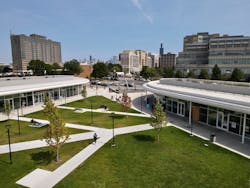The Illinois Medical District: At the Heart of Healthcare Collaboration in Chicago
Collaboration is in the air in Chicago, both on the provider side and more broadly, with patient care organizations in downtown Chicago collaborating in the support of the unique Illinois Medical District (IMD).
One of the organizations involved in the collaborative work has been the Medical Home Network, a Chicago-based managed care organization, has been working to transform care and building healthier communities by enhancing care coordination and quality, improving access and reducing fragmentation and cost. MHN, which was selected as one of the 2021 Best Places to Work in Healthcare, builds partnerships in the community to connect people with the care they need from comprehensive primary care to community-based organizations. Care teams build trusted relationships with patients and coordinate care with a focus on whole person health. The MHN model of care is powered by technology that connects a community-based healthcare system and enhances collaboration. That approach is improving outcomes, lowering costs and reducing health disparities.
And one strong focus in Chicago, in which the MHN has been involved, has been the creation and expansion of the Illinois Medical District (IMD), which was created in order to strengthen the healthcare provided to hundreds of thousands of Chicagoans. The IMD is a 560-acre special use zoning district in Chicago that was established in 1941 via state statute. It consists of medical research facilities, labs, a biotech business incubator, two universities, raw development area and more than 40 healthcare related facilities. We’re located less than two miles from the loop, and we’re anchored by four major hospitals: Rush University Medical Center, John H. Stroger, Jr. Hospital, the Jesse Brown VA and the University of Illinois Hospital. The IMD is one of the largest urban medical districts in the US, and has one of the most diverse patient populations. In terms of activity, the IMD fosters economic growth within the district by supporting healthcare, research, program, technology commercialization and real estate development initiatives. We also facilitate collaboration among clinicians, academic researchers, private industry and patients. We accomplish this by brining institutions and individuals together to achieve common goals and needs.
As IMD leaders indicated in a statement shared with Healthcare Innovation, “We have authority over zoning and land use within the IMD. To that end, we are required by law to provide a comprehensive master plan for the District. In 2016, we completed an extensive update to our existing Master Plan. This plan provides a “road map” for coordinated development and lays out one cohesive vision for the District. The plan incorporates feedback from Aldermen, County officials, community leaders and our IMD partners. We also held a community meeting and a public comment period. Our vision for the District impacts all of our stakeholders, from elected officials to community members, so was important that we shared this plan widely.”
As Israel Rocha, M.D., CEO of Cook County Health, said in a statement, “During COVID… it was about how all hospitals partner to get things done and share resources.” Cook County Health is a partner of the Illinois Medical District, one of the largest collaborative medical districts in the country. Another partner of the IMD is Mount Sinai Hospital, and their CEO, Karen Teitelbaum, recently said that “[Mount Sinai] is all about partnership. We rarely do anything without partners in the community.” Both CEOs recognized that collaborations between hospitals have allowed their institutions to thrive, particularly in the face of COVID and other threats. If the care delivery system is to succeed in the future, collaboration among hospitals like at the IMD will be imperative.
Recently, Healthcare Innovation Editor-in-Chief Mark Hagland spoke with Kate Schellinger, interim executive director of the IMD, about the ongoing evolution of the IMD and her perspectives on how collaboratives like the Medical Home Network can be effective in facilitating collaborative work to support optimal care delivery in communities like Chicago. Below are excerpts from that interview.
Tell me about the Illinois Medical District, and how it functions?
So we’re a unit of local government, created by state statute in 1941; we were created to be a life sciences/health sciences health system: Rush, Stroger, VA Medical Center, and the University of Illinois-Chicago (UIC) Hospital, four anchors. Also, Rush University, including its medical school, dental school, pharmacy school, and nursing school. We also have the participation of the Red Cross of Greater Chicago, the FBI Chicago Field Office, Easterseals; all organizations involved in public health or social services. 560-acre campus, geographically designated. We have a seven-member board of commissioners, politically appointed by the governor, county executive, and mayor. We have a staff of 14 people.
What is your background?
I have been in the interim ED role since February; I’ve been at the IMD for five years. I worked for the Chicago Department of Health before that, in emergency preparedness.
What has been your organization’s and the collaborative’s, experience of the COVID-19 pandemic?
Prior to COVID, we had always seen ourselves as a convener. And there are certain clinical areas where the hospitals might be competitors for the same patients; but there are areas like community health, where they can come together around community health—things like transportation, or like shared services, such as laundry. There’s a huge initiative called West Side United, which includes our anchor hospitals as well as many other partners around education and social services, with the goal of closing the life expectancy gap. A 14-year difference in life expectancy between the West Side and the Loop. So, economic vitality, access to healthcare. We’ve been involved in that. So that’s an example of collaboration.
So during COVID, because we already had these strong relationships with hospitals at IMD. So in March 2020, we immediately reached out to offer our help. And what we heard back was that they’d love it if we could convene them on calls and let them share what they were struggling with and resources. So everything from ventilator availability to needing to bring on more staff, staff surges. So we had those calls based on a frequency decided by the hospitals. We let them decide. We held the calls through about June and then said, we’re doing OK. And the beginning in November we reconvened them again. The same issues around staffing and surge, but we also started adding in vaccination discussions, in terms of vaccinating their staff and priority groups in the public, starting in January.
And what was their experience of the convened meetings?
I think it was a great forum for them; we handled all the administrative issues, sent out notes, so it was just a great place for them to share. If there was some commonality of interest, they could pursue things.
Did the hospitals share certain types of resources?
I can’t share specifically, but they may have shared things outside our calls.
Have you ever shared learnings with other medical districts, such as Houston’s?
I’ve done research into what other medical districts are doing; and there’s a lot of work around best practices for anchor missions. That feeds into the West Side United work. We’ve definitely studied what makes them successful.
And what does make them successful?
Being an environment where this kind of collaboration can occur; so, having a very well-rounded group of stakeholders, as well as being a very vibrant element of the city. We want this to really become a 24/7 type of environment, a place where you can work and play; that’s what we really want to achieve in the district.
How do you interact with the city, county, and state governments?
The county is a big landholder in the district; they have the old county hospital, which is now mixed-use development; and they’ve expanded the Stroger Hospital. So we’re definitely supportive of them. We work with them a lot around zoning and building. We oversee the zonings in the IMD, and collaborate a lot with the city, as well as working with World Business Chicago, an economic development arm, so bringing in additional life sciences companies. And we still have a strong relationship with them. At one point, the IMD was a state agency; now we’re our own unit of government.
What has happened to the old Cook County Hospital facility?
It was shuttered for some time; now it’s a hotel; it has a food hall, it has some offices for Cook County Health. It’s a beautiful project, it’s called Harrison Square.
What are your biggest challenges? Is one of them that you have numerous missions?
You could say that. Also, we have a private hospital, a county hospital, a veterans’ hospital, and a state hospital—just being sensitive to the priorities and needs of those diverse organizations, is a challenge. Also, bringing more attention to the IMD. If you know Chicago, think of Roosevelt Road and south, there are several parcels of vacant land that are part of a federal opportunity zone. And so we’re seeking out partners; we think we could grow some private-sector business in that part of the district. So we just want to get our name out there. So people think of Texas Medical Center, hubs in Boston or the San Francisco Bay Area; so we want to get our name out there so it’s as well-known as those others.
What does the near future look like?
A through line will be this collaboration; we want to be known as an innovation organization known in the area and beyond. An area where students want to come to be educated, where patients will want to come for care, and a destination for businesses and other partners, to continue to grow and sustain this ecosystem that we have already.
Is there any role for the federal government in all this?
We have our Jesse Brown VA Center, and we’re very supportive of all the programming and expansion that the VA’s working on. There are things coming to expand some of their services; that’s our biggest link to the federal government.
What should clinicians and administrators understand about the IMD?
We’re a world-class destination; it’s a great place to work because of what we’re trying to do in terms of building out the amenities. The Harrison. The Gateway Development, which is on IMD land. It’s a great place to live, work, and play, and provides everything in one really unique area of the city.
Is there anything that you’d like to add?
I think we’ve covered a lot of ground. We are really excited for our continued opportunities. West Side United—there’s a lot going on there. We’re just really excited about the current trajectory we’re on.
Sponsored Recommendations


